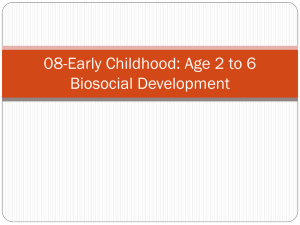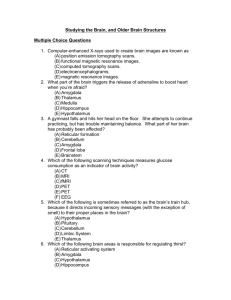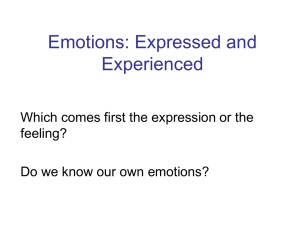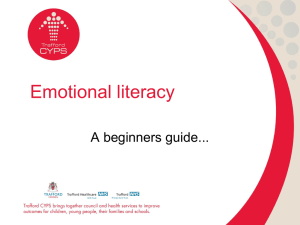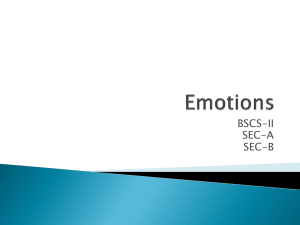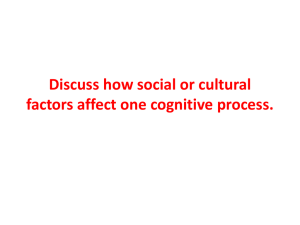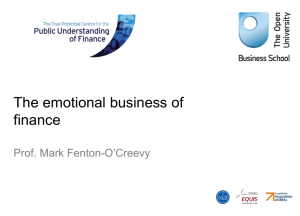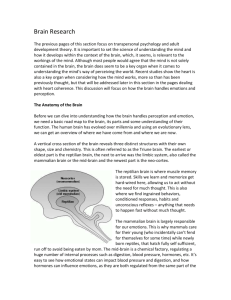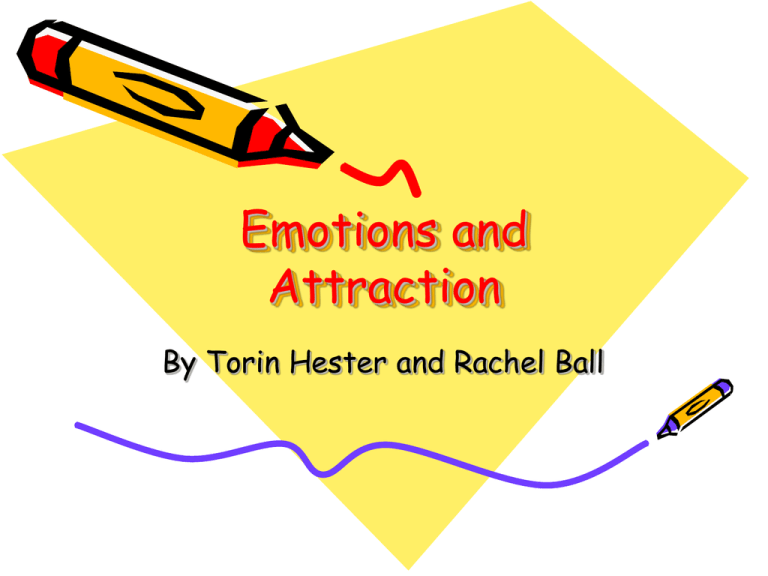
Emotions and
Attraction
By Torin Hester and Rachel Ball
Emotions
•
•
An emotion is..
A mental and physiological
state associated with a wide
variety of feelings, thoughts,
and behavior
•
Any strong feeling
But where do emotions come from? How
are they made? How do we experience
them?
Where They Come From
Although many theories as to how emotions come to be exist, we know that they take
place in the limbic system. This system deals with other elements concerning
regulation of memories, "fight or flight" reactions and motivations, but most
importantly it concerns emotions. The parts of the limbic system that contribute to
this are the Amygdala (a small almond shaped structure) and the Hippocampus (a tiny
seahorse-shaped structure). The amygdala connects with the hippocampus, as well as
the Thalamus. This connection between these three parts of the brain allow it to
control and regulate emotions, such as anger, love and affection. It also helps to
maintain major things such as friendships and relationships as well as the expression
of moods (ex: crying, laughter, etc.) Below this is the Hypothalamus, which sends
instructions to the rest of the body.
Amygdala and
Hippocampus
•
Amygdala
- Causes reaction to emotions, situations
etc
EX: Happiness=Smile, Laughter
- Monitors amount of emotions.
EX: Keeps you from over reacting
•
Hippocampus
- Appears to be very important in
converting things that are “in your
mind” at the moment (in short-term
memory) into things that you will
remember for the long run (long-term
memory).
- Commits feelings aroused from
situations to memory.
Thalamus and
Hypothalamus
•
Thalamus
- Makes sure your facial expressions and
body languages matches your
mood/feeling
•
Hypothalamus
- Where “chemicals” called peptides are
made for moods/feelings
•
•
How do Emotions Come To Be?
Although we aren't exactly sure the entire science behind how emotions are "made"
we do know a few things. We know that when our bodies experience a feeling, the
hypothalamus makes a chemical for that specific emotion. These chemicals are
called peptides (small chained amino acid sequences). So when you feel sad, your brain
makes peptides for that specific feeling. When hundreds and thousands of these
are made, they are assembled into smaller chains called nueropetides, or
neurohormones and then are sent out to the blood stream. The hypothalamus
memorizes the format of the peptides so it will recognize the feeling the next time it
occurs. For example, the feelings that you experience on a daily basis (happiness,
stress, etc.) have had their peptide formation "drilled in your brain".
On every cell in your body is something called a receptor. These take in things to the
cell, like water, oxygen and nutrients.. When peptides make it to a receptor of a
cell, they then lock in with it. Think of this process much like how a key would
slip into a lock. After this happens through out the body, you begin to completely
experience the emotion.
•
Well, I guess "completely" wouldn't be the right word. These peptides also must go
through the Amygdala to monitor the amount of the emotion so to say. For
example, if your cat dies, the amygdala won't send out enough peptides to the
receptors to make you want to commit suicide. Instead you'll just be kindly upset. The
amygdala helps to keep you from over-experiencing certain emotions.
•
In the thalamus during this process, peptides are sent to here where they are read.
After doing so, the thalamus determines whether or not your facial expressions and body
language match the feeling. If the emotion is happy, you'll generate laughter. If the emotion
is sad, you'll generate tears. It also helps to make sure you don't crack up and smile
uncontrollably when you should be scared, for instance if a bear was preparing to attack you.
The thalamus makes sure you match what you're feeling.
•
The hippocampus comes in to play by committing to memory the feelings, and what you
associate with them. For example, if you were ever in a bad relationship, then instead of
remembering love as something full of happiness, you may recall it as hurtful or upsetting.
This affects emotions because of the way things have been registered in your mind. If your
brain remembers how a situation made you feel, it will bring up that feeling when that
situation is brought up again, until you rewrite the situation. If you were once attacked by a
dog, you associate dogs with fear, unless you get a dog and it changes your perspective on it.
Now instead of putting dogs and the emotion of fear together you may put dogs with the
emotion of happiness together.
The Basics of Attraction
People are subconsciously
wired to be attracted to
people with symmetrical
and proportional
features, which makes
them appear healthy and
free from disease.
Even if you aren’t flirting
with the intention of
having children with that
special someone, your
brain and optical nerve
are working together to
decide if your crush has
traits that would do well
passed on to offspring.
“The ideal face of an attractive
woman, according to experiments
with men, has high cheek bones,
big eyes and a thin jaw.”
http://www.viewzone.com/attractive.female.jpg
Some Parts of the Brain
Involved
• The FUSIFORM,
located in the back of
the head near the
spine. It is the same
neural pathway used
to recognize other
people, and damaged
fusiforms render
people unable to
recognize anyone or
determine beauty.
• GnRH NEURONS,
responsible for sexual
behaviors and control
of the pituitary gland,
which controls
puberty and hormones.
Some Parts of the Brain
Involved (continued)
• The HYPOTHALAMUS also
• SEROTONIN is
releases of hormones
another hormone that
including PEA
(Phenylethylamine),
controls mood, and is
commonly called the
the culprit of violent
“molecule of love” which
behavior.
emits feelings of euphoria
• OXYCOTIN is being
and gives the feeling of
studied for it’s possibility
“falling in love.”
to influence bonding in
• The hypothalamus also
adults. Female prairie voles
releases DOPAMINE,
deprived of oxycotin will
which makes you more
not bond to males, while
talkative to a potential
ones exposed to it will
significant other, and
bond to a specific male.
makes you focus your
attention on them.
Pheromones
•
•
•
•
•
http://www.parrant.co.uk/my
adoption/pictures/pheromone
s%20and%20odours1.gif
•
Pheromones are debated to
exist in humans, and are used
to express health and to
attract the opposite sex.
Androstenone was discovered
at the Chemical Senses
Center in Philadelphia, and
their partners in France and
is the pheromone given off by
men. It is found in men’s
sweat.
It’s even possible to buy
colognes and soaps with
pheromones in them.
The Vemeronasal Organ
(VNO) in the nose is formed
specifically to detect
pheromones.
Androstenone makes men
more attractive to women and
more dominant over other
men.
Pheromones are detected
unconsciously in humans. They
have no smell and are invisible.
sources
•
•
•
•
•
•
•
•
•
http://huehueteotl.files.wordpress.com/2007/04/amygdala_hippo
campus_lateral_large.jpg
http://psychology.about.com/od/biopsychology/ss/brainstructure
_6.htm
http://biology.about.com/library/organs/brain/blthalamus.htm
http://www.rhododendrites.com/blog/files/200906/hypothalamus.jpg
http://www.incrediblehorizons.com/balance-Hypo%20function.htm
http://www.viewzone.com/attractiveness.html
http://totallyher.com/what-causes-attraction/
http://www.vetscite.org/publish/items/002552/index.html
http://relationships.blogcity.com/the_chemistry_of_attraction_in_the_brain.htm

